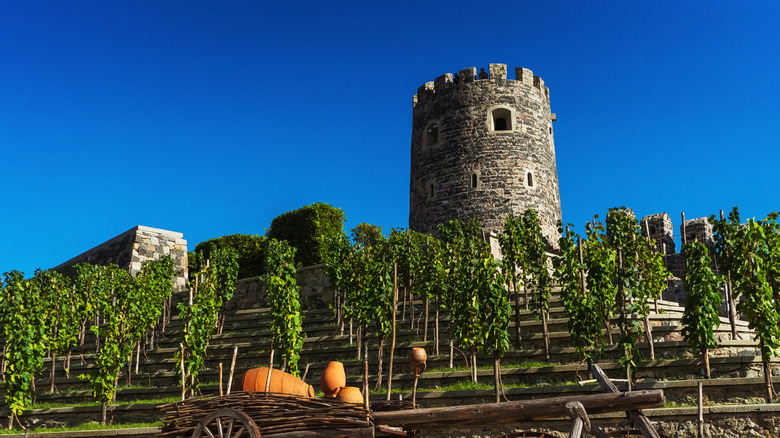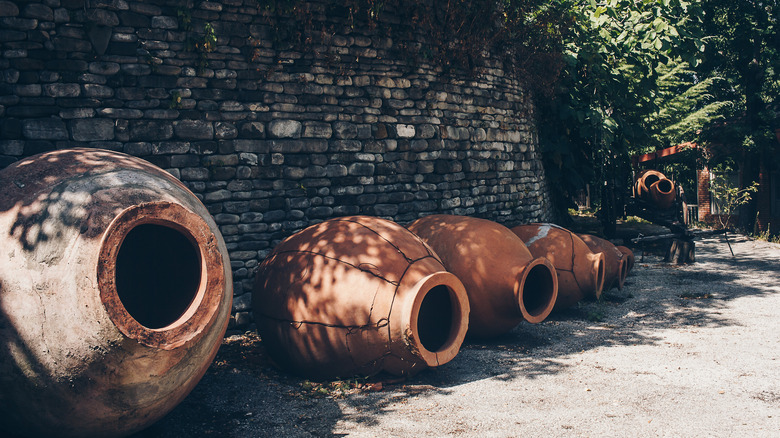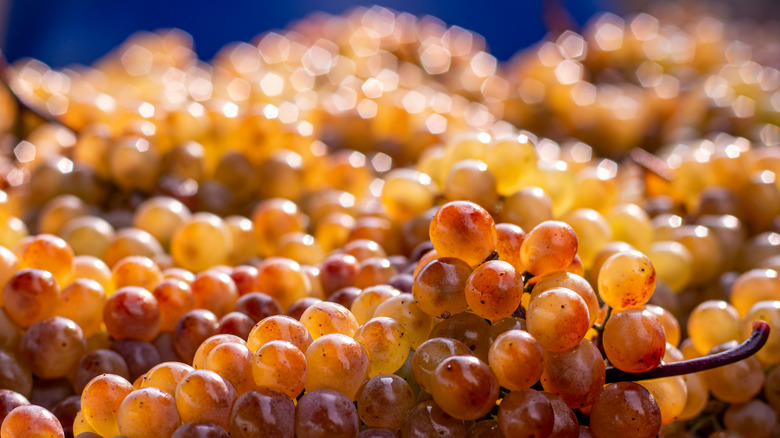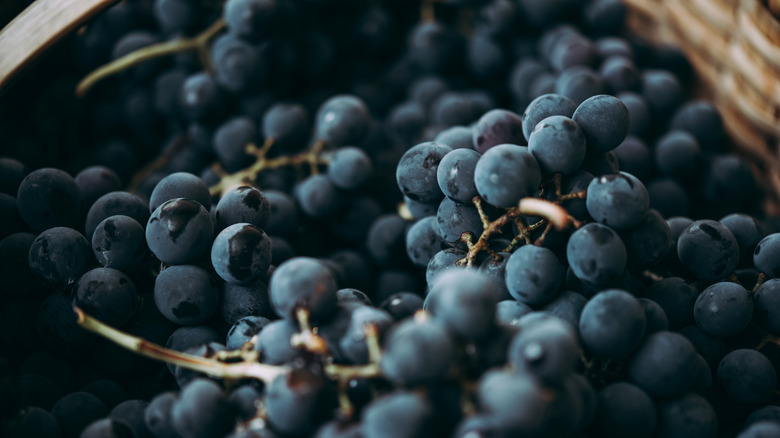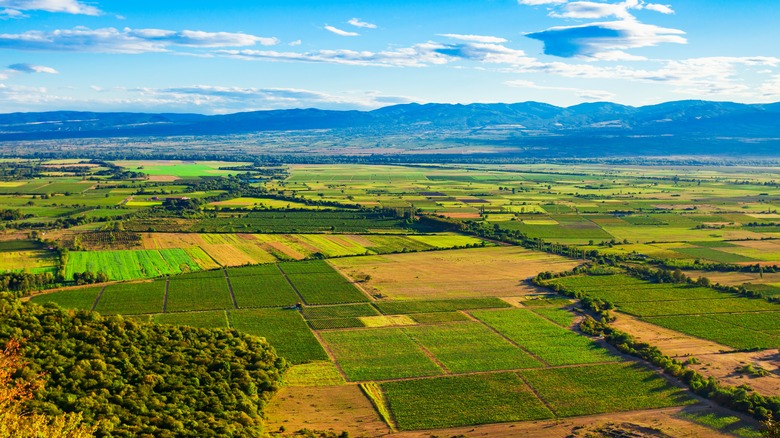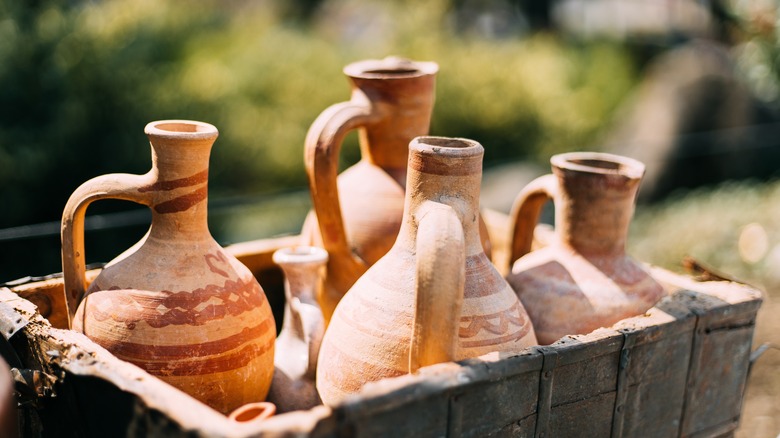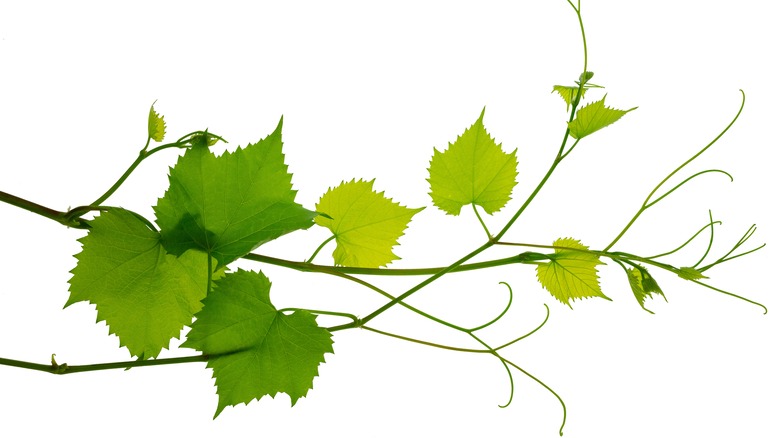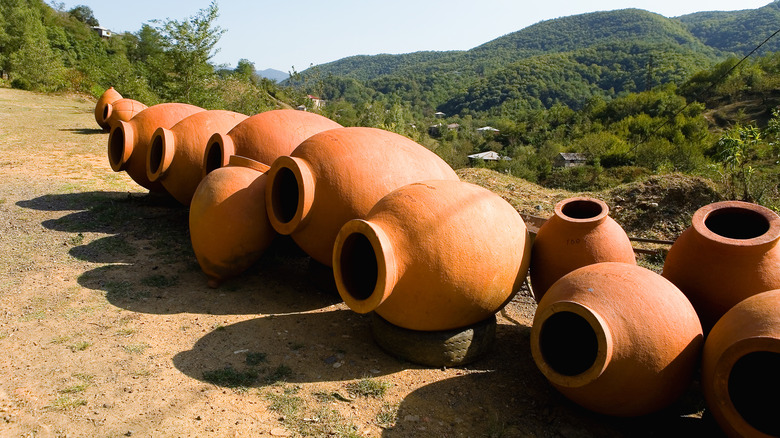The Beginner's Guide To Georgian Wines
Georgian wines may not dominate wine shop shelves in the U.S., but wine lovers dedicated to learning about the roots of wine history should delve into this Caucasus country's wine scene. According to National Geographic, Georgia is the birthplace of wine — archaeologists have discovered the oldest evidence of wine in the country.
But there's more to Georgian wine than what we can learn from the past. According to Erika Frey, wine educator and co-founder of Saperica, an organization dedicated to promoting Georgian grape varieties and culture in the U.S., Georgia offers wine lovers a slew of native varietals not found in other parts of the world. If you haven't explored the region before, there is plenty to discover.
The climate of Georgia puts it in a prime location for grape growing. According to Frey, the country's temperate climate is ideal, and the many mountain ranges in the region are responsible for a wide range of mesoclimates, which allow wine producers to produce a variety of styles. Let's take a closer look at what makes Georgian wine so special so you'll have the basics down as you begin to explore this exciting region.
Some Georgian winemakers use clay vessels called qvevri
Perhaps one of the most iconic aspects of winemaking in Georgia is the qvevri, which, according to Erika Frey, is a cone/egg-shaped clay vessel that's used both for the fermentation and maturation of wine. Other countries use clay vessels, but what sets qvevri apart is the fact that they are generally buried underground, with only the top opening of the vessel above ground accessible to the winemaker. Generally, these vessels hold around 1,000 to 1,500 liters, though size can vary. The clay is similar to stainless steel in that it doesn't impart much flavor to the wine, but it can promote some oxygenation, similar to (though less than) an oak barrel.
The most celebrated qvevri wines are skin-contact (also known as amber) wines made with white grapes. Frey says, "In the Kakheti region, the length of the skin-contact is often six months, which creates an amber-colored wine rich with flavors of dried fruit, honey, and tea and full-bodied with high levels of tannin."
In the past, this kind of winemaking was reserved for private homes, churches, and monasteries. "This style of wine has only recently become a commercial export," says Frey.
Rkatsiteli and saperavi are two of the most well-known Georgian grapes
If you're looking for Georgian wines in the U.S., chances are, you'll come across two dominant varieties. Are you generally more partial to white wines? If so, try rkatsiteli. According to Wine-Searcher, this grape is similar to a high-quality Petit Chablis or a northern Italian pinot grigio. Expect notes of green apple, quince, and white peach. It's generally easy-drinking and light, though Wine Folly reports that it can also be made in more intense, oxidative styles.
When it comes to red wine, the Georgian variety you'll likely encounter the most is saperavi. Per Wine-Searcher, this dark-skinned grape can produce wines with a marked-color intensity along with high acidity. It has often been used to make cheaper wines, but as of late, many producers are taking this grape seriously by producing high-quality premium wines, often aged in oak, that can last for years in the bottle. Since it ripens late, it can be cultivated in cooler climates without risking frost damage — it's now finding a new home in New York's Finger Lakes region.
But there are many other native grapes to check out
Just because rkatsiteli and saperavi may be the dominant Georgian grapes you'll come across doesn't mean you shouldn't explore more of what this region has to offer. Erika Frey lists other native Georgian varietals consumers can seek out, including Kisi, which is "a moderately aromatic variety from Kakheti with lovely notes of stone fruits like apricot and peach." This grape is sometimes vinified in stainless steel. Other times, it will be fermented in clay vessels called qvevri to make a skin-contact, or amber, wine.
Another grape to check out is tsolikouri, which comes from western Georgia but is expanding its reach into the rest of the country. Frey says it has "naturally bright acidity with notes of ripe apple and pineapple and some herbal hints." Don't miss out on tsitska, which makes crisp white and sparkling wines; otskhanuri sapere, which produces high-acid reds similar to cabernet franc; and aleksandrouli and ojaleshi, which yield medium-bodied reds with notes of red fruit and spice. And for all the pinot noir lovers out there, shavkapito is likely to impress.
Georgia is famous for its skin-contact white wines
For the past several years, orange, or skin-contact, wine has been having a moment. And no, these wines aren't made from oranges — according to Wine Folly, orange wine is made by treating white wine grapes like red wine grapes. While winemakers will generally press their white grapes immediately, separating the juice from the skins, in red winemaking, the grapes are left in contact with the skins, which allows for the extraction of color, flavor, and tannin. With skin-contact wines, the white grapes are left on their skins for a period of time, allowing those colors, flavors, and tannins to play a role in the final product.
You can find skin-contact, or orange, wines all over the world, but the skin-contact wines made in Georgia are special. According to Erika Frey, "Georgia has a long and continuous tradition of making skin-contact white wines, which they call 'amber' wines. These are usually much more intense in terms of color, flavor, and body when contrasted with 'orange' wines that you might find from other countries." Generally, this process is carried out in a qvevri, though it doesn't have to be.
If you've already tried orange wines and enjoyed them, it might be time to venture into the world of Georgian amber wines.
The Kakheti region in eastern Georgia is the primary grape-growing area
Grapes can be grown all over Georgia, says Erika Frey. However, the bulk of the production happens in Kakheti, which accounts for around 70 to 75% of the country's total production. It's also the area with the most Georgian wine PDOs. Rkatsiteli and saperavi are the main grapes grown in this area, but other native varietals can be found here as well. However, Kakheti is a warmer region, and as climate change continues to shake the wine industry, some wine growers are finding that Kakheti isn't always able to produce high-acid varieties.
Enter the Kartli region, which has a slightly cooler climate. New, young winemakers seem to be settling in this region, and many are focusing on the white grapes of chinuri and goruli mtsvane, as well as the black varieties of tavkveri and shavkapito.
Even western Georgia is getting some of the action with areas like Imereti, Racha, and Lechkhumi, which also boast cooler climates that are more appropriate for high-acid grapes. Tsitska, tsolikouri, and krakhuna are common white grapes, while the black grapes of Otskhanuri sapere, ojaleshi, and aleksandrouli also shine.
Georgia is the oldest recorded grape-growing region
When you think of places with a long history of wine production, countries like France and Italy might come to mind. But it turns out that the oldest recorded traces of wine production lead not to France but to Georgia, per National Geographic. Per Erika Frey, "The oldest grape wine residue has been found in Georgia dating back to 6,000 B.C." That means that Georgia has been producing wine for at least the last 8,000 years. Georgians in these times discovered that burying grape juice underground during the winter resulted in wine — some of these wines could survive underground in qvevris for 50 years. Even ancient Georgian art depicts grapes and wine, highlighting their importance to the culture of the time.
By contrast, it's estimated that the French started making wine around about 425 B.C. — thousands of years after proof of Georgian wine production — after they appeared to have learned the process from the Italians. So while, yes, every wine region has a rich history worth exploring, the history of Georgia's wine culture goes back further than any other country's.
The grapevine is an important symbol in Georgia
According to Erika Frey, it's not just wine itself that's important to Georgian culture — it's the grapes and grapevine in general. There are many facets of the culture that reflect the importance of the fruit. For example, when Georgian warriors would go to battle, they would carry a grapevine cutting with them. The idea was that a grapevine would grow wherever it fell. Even today, she says, it's possible to see grapevines growing all over the capital city of Tbilisi on balconies and walls. St. Nino, who brought Christianity to Georgia, reportedly came to the country with a "cross woven with grapevines and her hair."
And the food culture of the country is also steeped in an appreciation for wine. One tradition Frey references is called "supra": It's a "tradition of the celebratory meal ... marked with toasts of wine led by a 'tamada' or toastmaster." Extra grape juice can even find its way into the food itself. Pelamushi and churchkhela, traditional Georgian desserts, are even made with leftover grape juice from the harvest.
The market for Georgian wine in the U.S. has been growing
If you live in a big city in the U.S., it's probably not too difficult for you to find Georgian wine at a local wine shop. According to Erika Frey, "The market for Georgian wine in the USA has been growing! The exports to the USA have increased by an average of 30% per year for the past few years. With the USA as one of the identified target markets, Georgia hopes to increase its wine exports to the USA to 10 million bottles per year."
As more and more wine consumers start to experience Georgian wines and grow to love them, they're likely to create even more demand in the market. So, what should you do if you want to try Georgian wine but can't find a shop near you that sells it? Frey offers some suggestions: "If consumers cannot find Georgian wine in their local shop, they may be able to contact an importer or distributor to find the closest local shop. One of the largest national distributors is Georgian Wine House based in Washington, D.C. There are also a few shops that may ship Georgian wine to you, such as Potomac Wines And Spirits and Astor Wines & Spirits."
The majority of Georgian wine exports still go to Russia and other former Soviet countries
Although the U.S. may be gaining greater access to Georgian wine, there are still other countries in the world that drink way more of the stuff. One of those countries is Russia; according to Erika Frey, much of Georgia's wine market makes its way there and to other former Soviet Union countries — this is likely where you'll have the easiest time finding a wide array of Georgian wines outside of the country itself.
But Georgia's wine industry is expanding. Now, Frey says, exports to Western Europe and Asia, in addition to the U.S., are on the rise. In fact, the Georgian National Wine Agency has devised a list of its target export markets, including countries like the U.K., U.S., China, Japan, Germany, Poland, and the Baltic states. Additionally, Georgian producers are hoping to send more of their wines to South Korea. In the future, it's likely that we'll see Georgian wines being distributed on a much larger scale.
The Georgian wine trade is deeply affected by foreign politics
Just like any other agricultural product, wine can be affected by sociopolitical issues. Erika Frey says Georgian winemakers "have been rebuilding and redefining their wine industry since the fall of the Soviet Union." In 1921, the Soviet Union took control of Georgia, forcing the country's winemakers to either surrender their land or their entire crop, according to Atlas Obscura. In the midst of this tragedy for Georgian winemakers, some of these celebrated winemaking traditions almost died out.
And sociopolitical pressures continue to affect the Georgian wine industry today. One reason Georgia has pushed for a wider export market for its wines is due to Russian foreign policy: "A 2006 embargo on Georgian wine by Russia really pushed Georgia to explore other markets for their wine; however, they still rely on Russia and other former Soviet countries for the majority of their exports," said Frey. "The COVID-19 pandemic and 2022 war in Ukraine brought about many challenges for the Georgian wine industry in recent years in terms of production, loss of tourism, supply chain delays, and access to their largest export markets."
Tbilisi is a great place to check out the country's wine scene
So, where should you go if you want to explore Georgia's wine scene? Per Erika Frey, Tbilisi is the best first stop: "The capital city of Tbilisi has many wine bars and wine shops. Many of the large wine producers are also represented with their own shops, tasting rooms, and restaurants in the city. In Tbilisi, it is easy to get around by walking, taxi, or metro. 8000 Vintages is a wine bar and shop with several locations around the city."
And for those who want to get outside of the city and get a closer glimpse at how the wines are actually made, hiring a tour guide may just be your best bet, as public transportation may not get you where you need to go. "There are many guides who specialize in wine tourism, and they can make arrangements for transportation and accommodations," said Frey. "Many wineries have rooms, hotels, or resorts. Georgian hospitality is famous — you will never go hungry, there will be plenty of wine, and often entertainment will be offered in the form of Georgian song, music, and dance."
